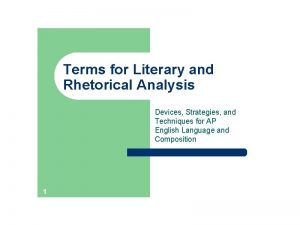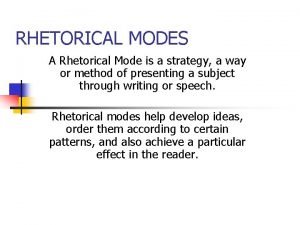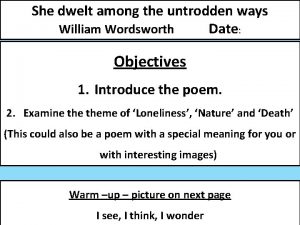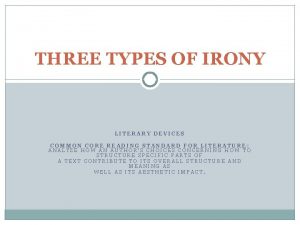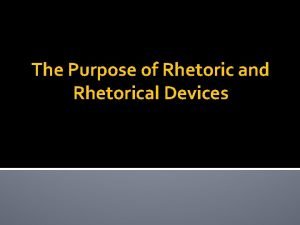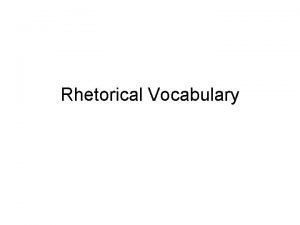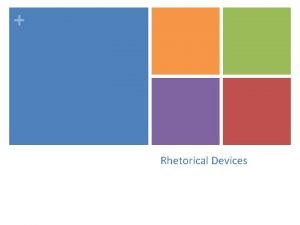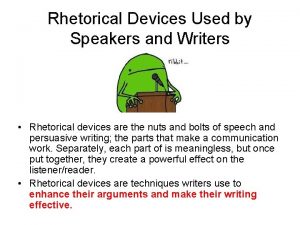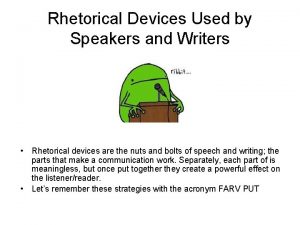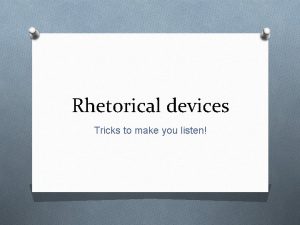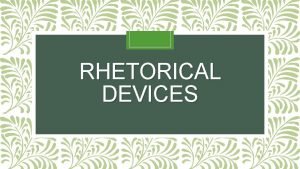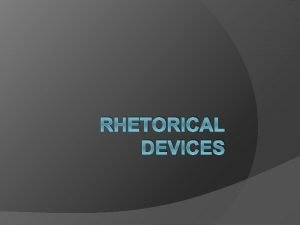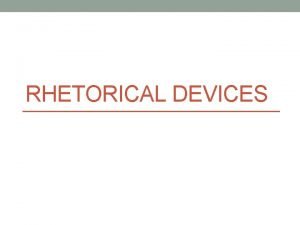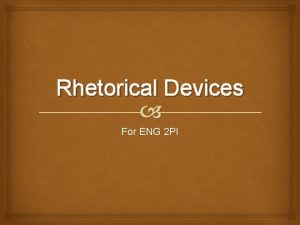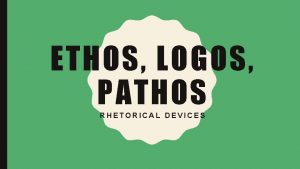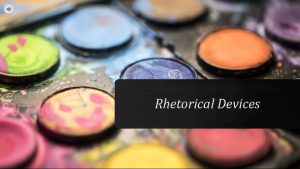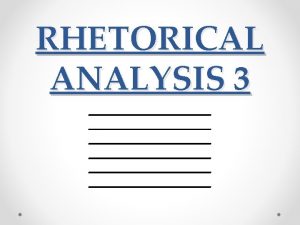RHETORICAL DEVICES Analysis of Literature Rhetorical Devices ways














- Slides: 14

RHETORICAL DEVICES Analysis of Literature

Rhetorical Devices: ways of expressing ideas that are unusual. Writers use rhetorical devices to achieve special effects in a passage. Authors achieve these effects by the way they arrange their words. These devices can be found in poetry, stories, essays, speeches, editorials, and advertisements.

Alliteration: the repetition of the same consonants in lines of poetry or prose. Examples: 1. “Droning a drowsy syncopated tune, ” - Langston Hughes (repetition of “d” and “o” sounds). 2. “I like to see it lap the miles. / And lick the valleys up. ” - Emily Dickinson (repetition of “l” sounds)

Analogy: a comparison between two things or ideas. Examples: comparing life to a journey, comparing students in a school to the members of a family.

Euphemisms: using mild words to describe something instead of using offensive or sexist words. Examples: 1. passed away for died 2. perspire for sweat 3. restroom for bathroom 4. sanitation engineer for trash man

Hyperbole: exaggeration to create an effect. Examples: 1. I would rather die than eat Brussels sprouts! 2. I was so surprised you could knock me over with a feather!

Metaphor: direct comparison between two unlike things without using the words “like” or “as. ” Examples: 1. The sun was a ball of fire. 2. “Life is but an empty dream!” Longfellow

Onomatopoeia: words whose sound suggests their meaning. Examples: 1. splash, buzz, hiss, boom 2. “The moan of doves in immemorial elms; / And murmuring of innumerable bees, ” Tennyson

Personification: giving human qualities to something not human. Examples: 1. “As she sang softly at the evil face of the full moon. ” Jean Toomer 2. “The oak trees whispered softly in the night breeze. ” John Steinbeck

Rhyme: occurs when the last words have the same sounds. Examples: 1. “The old horse thrust his long head out, / And grave with wonder gazed about. ” Whittier (out and about rhyme. ) 2. “Happy the man who, safe on shore, / Now trims, at home, his evening fire; / Unmov’d, he hears the tempests roar, / That on the tufted groves expire. ” “The Hurricane” by Philip Freneau (rhymes are shore/roar and fire/expire)

Simile: comparison between two things using “like” or “as. ” Examples: 1. “Sometimes I feel like a motherless child. ” African. American Spiritual 2. “My love is like a red, red rose. ” Robert Burns 3. Free as a bird.

Tips for Understanding Rhetorical Devices Study the definitions and examples of alliteration, analogy, euphemisms, hyperbole, metaphor, onomatopoeia, personification, rhyme, and simile.

Tips for Answering Questions about Structural and Rhetorical Devices Read the literary selection at least twice. Try to summarize the selection in your own words. Decide which answer best describes the structural or rhetorical device you are asked to read. Choose your answer, and then confirm it by going back to the selection.

Reference Chapter 7, Passing the New Alabama Graduation Examination in Reading, American Book Company
 Parallelism definition literature
Parallelism definition literature Gods ways are not our ways
Gods ways are not our ways Literary techniques vs devices
Literary techniques vs devices Definition rhetorical mode
Definition rhetorical mode She dwelt among the untrodden ways questions and answers
She dwelt among the untrodden ways questions and answers Poetic devices irony definition
Poetic devices irony definition Asyndeton examples
Asyndeton examples Cicero rhetorical devices
Cicero rhetorical devices Appostive phrase
Appostive phrase Rhetorical devices
Rhetorical devices Literaty devices
Literaty devices Rhetorical devices in disney songs
Rhetorical devices in disney songs Rhetoric literary devices
Rhetoric literary devices Triad literary device
Triad literary device Rhetorical devices symbolism
Rhetorical devices symbolism
